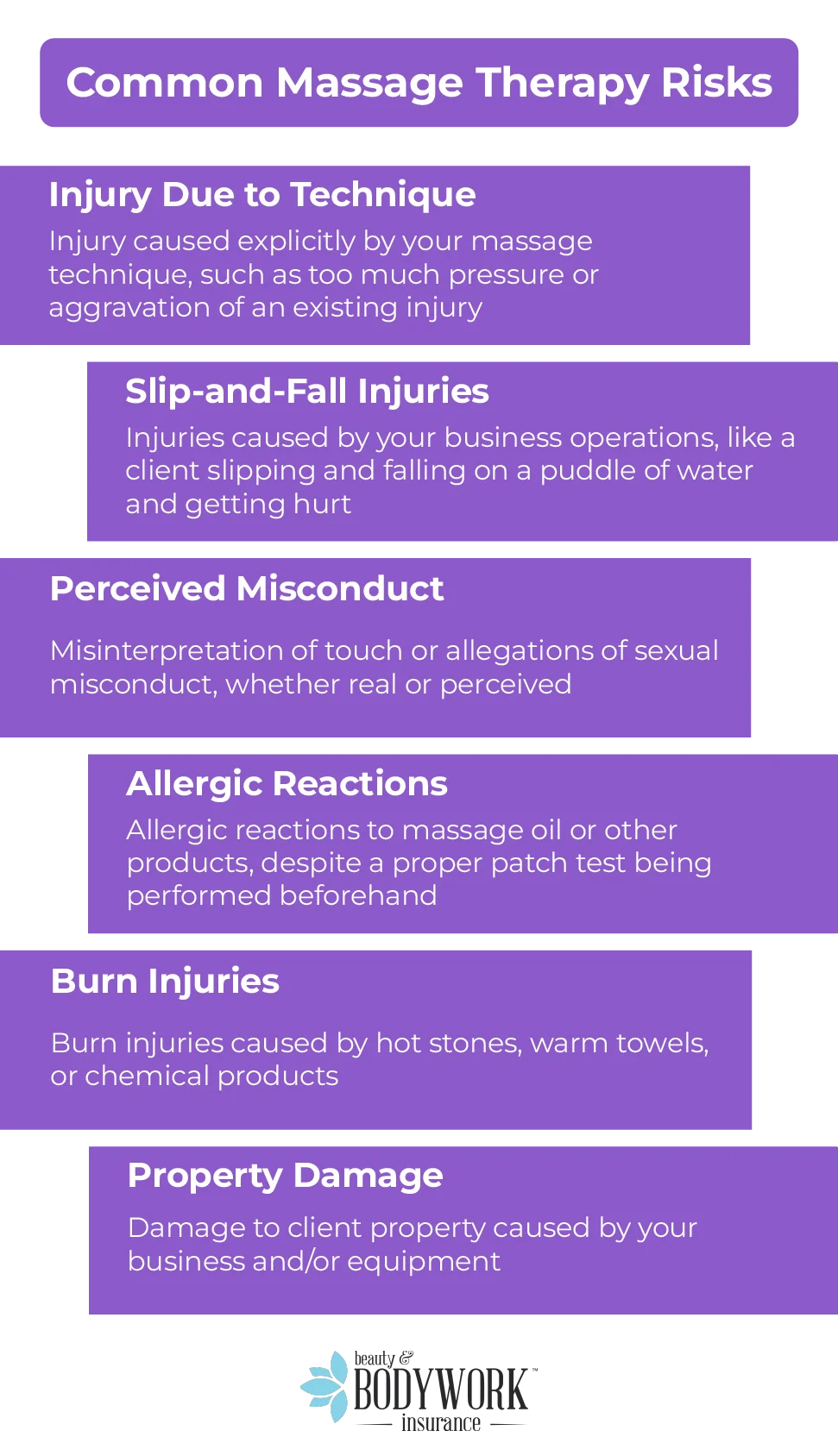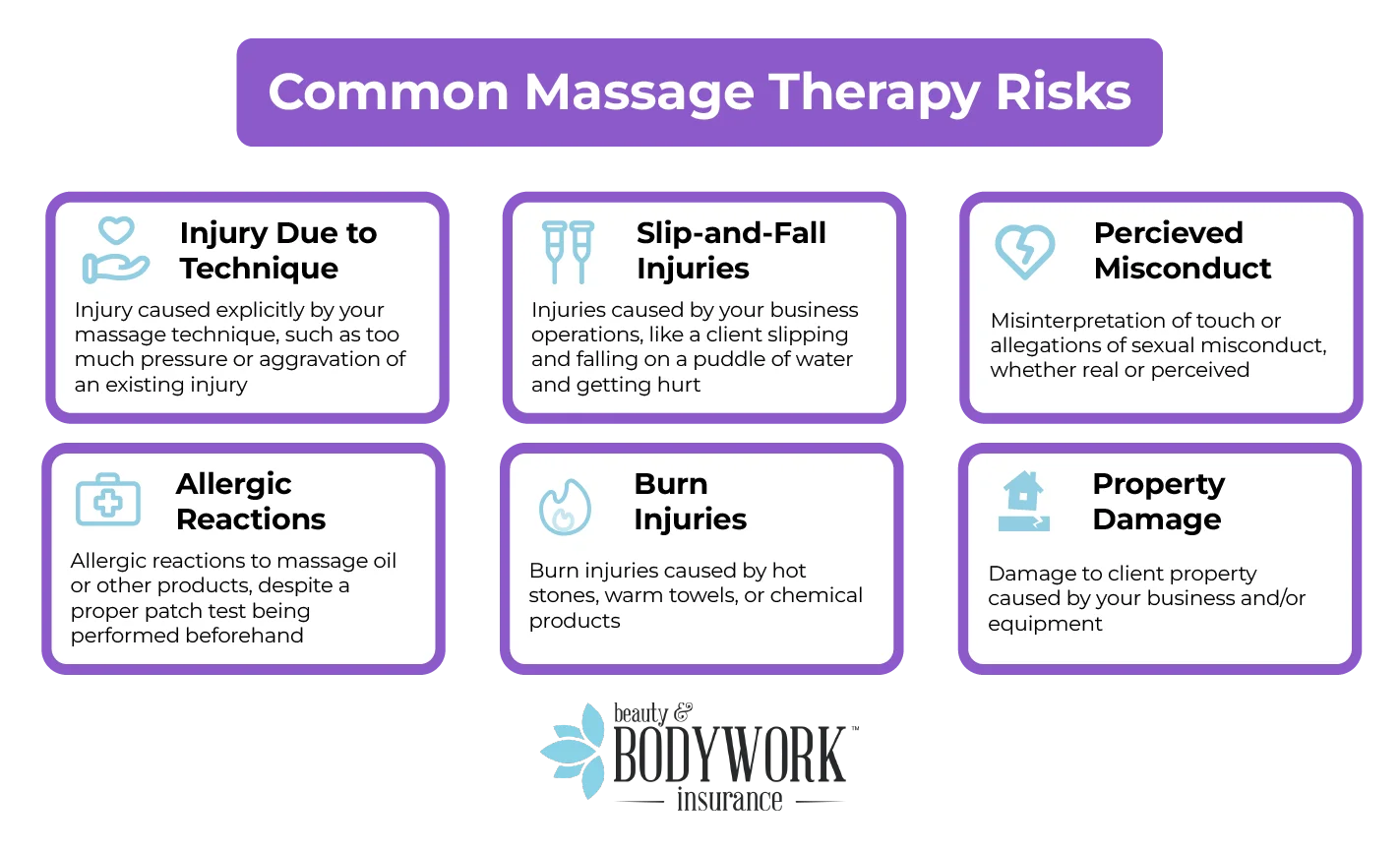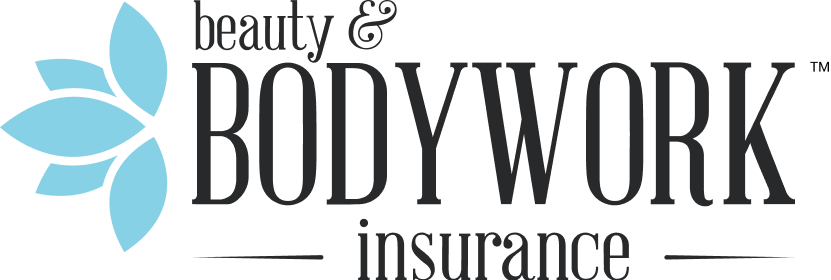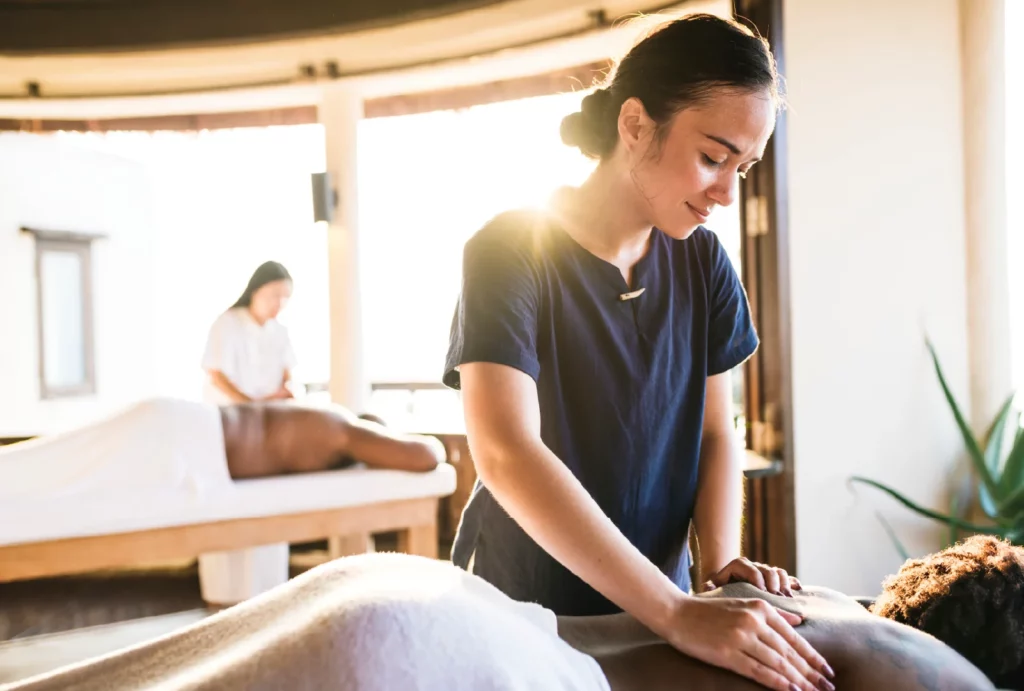Fluffy towels, calming scents, utter relaxation — massage therapy is all about promoting wellness. As you create the perfect experience for clients, you’re also thinking about how to keep them and yourself safe.
Massage therapist risk management is an ongoing process that is essential to limiting your chances of facing an expensive lawsuit or reputation damage. Let’s dive into 12 tips you can implement today to protect your practice!
Plus, we’ve got a free checklist for you right here. Cue the sigh of relief.
Download a Free Massage Therapy Risk Management Checklist
Tips for Client Safety in Massage Therapy
A large part of risk management for massage therapists is minimizing the potential for client harm, whether physical or otherwise. You already care about your clients — you’re a massage therapist, after all! But these are actionable steps you can take to ensure their protection.

1. Use a Thorough Intake Form
Everybody is different, so gaining a clear understanding of each new client before accepting them is crucial.
Have potential clients fill out a thorough intake form with a written or electronic signature. This records their understanding of their current physical condition, expectations, and acknowledgment that you’ve adequately explained the treatment plan.
Include questions like:
- Why are you seeking massage therapy?
- Are you under a doctor’s care or taking medications?
- Do you have any conditions (e.g., high blood pressure, diabetes)?
- Are there areas you’d like to avoid or focus on?
- Are there any areas of pain?
- What are your energy levels like?
- When was your last massage and how did it go?
- What would make this massage a success for you?
How this keeps clients safe: An intake form prompts clients to disclose any relevant information that could affect how their body reacts to massage. Properly store these forms in a locked physical cabinet or in a secure place digitally so the information cannot be disputed later.
2. Communicate Clearly
Reminder: Your clients don’t know much about massage therapy — but you do! You can’t expect them to understand everything you do during a massage without receiving that information from you first.
Communicate what you’re doing, which techniques you’ll use, and how they should be feeling before, during, and after service. Most importantly, be sure they understand they can speak up if something feels wrong.
Encouraging questions and check-ins throughout each session builds trust and reduces the chances of misunderstandings.
How this keeps clients safe: Clients feel empowered to let you know of any discomfort or concerns, helping prevent physical or emotional harm.

3. Create a Clean, Safe Environment
When clients step into your massage space, it should feel relaxing and welcoming. But more importantly, it must be physically safe and hygienic.
Maintain a clean, low-risk environment by taking these steps regularly:
- Light candles only when you can see them
- Sanitize tools, surfaces, supplies, linens, and equipment
- Secure rugs, cords, and floor items to prevent trip hazards
- Ensure your massage table or chair is set up properly
- Keep your walkways and workspace free of clutter
- Be mindful of weather-related hazards, like rain or snow
- Check towel and massage table warmers for malfunctions
- Properly label and store all products (cleaning supplies, massage oils, etc.)
- Make sure your entrance is accessible to all, including those who are injured or who have disabilities
How this keeps clients safe: A clean, well-maintained environment reduces the risk of injury, illness, or allergic reactions.
4. Stay Prepared for Emergencies
You never know when an unexpected medical situation might arise. Whether it’s a client experiencing low blood sugar, dizziness, or even fainting, it’s essential to be prepared.
- Keep a stocked first aid kit
- Keep a quick source of sugar (like juice or glucose tabs)
- Get CPR– and first-aid-certified
- Have easy access to your phone in case of 911 emergencies
- Ensure each client’s emergency contact information is up to date
How this keeps clients safe: Responding quickly during a health emergency may reduce the severity of the incident and help protect your client’s well-being.
5. Avoid Treatment Beyond Your Scope
You’ve spent hundreds of hours earning your massage therapy license, and you genuinely care about helping clients feel better. But when you go beyond the scope of your professional training by offering medical diagnoses or using techniques you’re not properly trained in, you put your client’s safety at risk.
If a client shares symptoms beyond your knowledge, always refer them to a healthcare provider. Never try to address the issue yourself. Your practice should only offer what you know: massage therapy.
How this keeps clients safe: Staying within your scope prevents injury from inappropriate treatment and ensures clients get the care they truly need.

6. Protect Private Information
Risk management for massage therapists also involves keeping clients safe from non-physical risks like data breaches. Your massage practice handles sensitive client information, including health details, home addresses, and credit card numbers.
Whether you store this data digitally or on paper, make sure it’s kept securely to better protect against cyber attacks.
- Use password protection and/or lockable storage
- Avoid discussing clients in public or shared spaces
- Be selective about which scheduling or payment platforms you use
- Ensure your business complies with privacy laws and regulations
How this keeps clients safe: Information security best practices help protect clients from data breaches — and build trust in your professionalism.
Massage Therapist Risk Management: Protecting Yourself
Managing risk for massage therapy is ultimately about protecting yourself and your business so you can continue doing what you love. Here are some tips for defending your practice, from your massage table to your advertising.

7. Document Everything
We’ve already mentioned client intake forms, but on top of that, you should keep a record of all interactions with your clients. Proper documentation is a powerful tool if you ever face a liability claim.
Document:
- Session logs
- Intake forms
- Liability waivers
- Treatment (SOAP) notes
- Client signatures on all forms
- Communication (such as text or email)
It’s important to note any changes in your client’s demeanor, especially if any concerns are raised. Always include the professional processes you followed throughout the session.
How this keeps your practice safe: Accurate documentation can demonstrate you’re not at fault if you ever face a claim or legal dispute.
8. Develop Clear Written Procedures
To limit your liability risks, create a written policy and procedure manual to ensure consistency in how you run your practice. If you have staff or contractors, this ensures everyone is on the same page regarding operations.
Your manual should include:
- Client intake
- Sanitation protocols
- Tableside best practices
- Equipment maintenance
- Communication standards
- Risk management checklist
- Employee training and expectations
Try using a procedure manual template to get started.
How this keeps your practice safe: Standardized practices reduce the chance of oversight, miscommunication, and inconsistent service that could lead to claims.
9. Watch for Client Red Flags
Unfortunately, not every client is a good fit, and some may pose a risk to your safety. Always trust your instincts if you feel something is off, and don’t hesitate to decline a session — it’s better to be safe!
Be wary of clients who:
- Make inappropriate comments
- Request same-day home visits without referrals
- Share emotional issues that go beyond massage therapy
How this keeps your practice safe: Screening clients helps you avoid potentially unsafe, inappropriate, or high-risk interactions.
10. Practice Cautious Marketing
Massage therapy marketing helps grow your client base, but it also opens you up to advertising injury claims if you’re not careful. Avoid using copyrighted images, making unrealistic claims, or mentioning your competitors unfairly.
Stick to using authentic testimonials, honest messaging, and original content as you promote your practice.
How this keeps your practice safe: Keeping your marketing strategies ethical reduces the risk of claims, such as libel or misleading advertising.

11. Invest in Liability Insurance
No matter how careful you are to reduce risks at your practice, you can’t be 100% certain things won’t go wrong. That’s where liability insurance comes in.
If you ever face a claim related to your practice, such as client injury, property damage, or professional mistakes, massage therapy insurance can pay to make things right with your clients.
Even a single claim can cost hundreds of thousands of dollars — potentially putting your practice out of business.
The main reason why massage therapists need insurance is to protect themselves financially and work with peace of mind. Carry the right coverage for those “just in case” moments, even if it’s not a state or work requirement.
How this keeps your practice safe: Massage therapy insurance covers legal fees and damages if you face a claim, keeping your practice running smoothly.
12. Stay Connected With Peers
Not only is networking with other massage therapists in your area great for growing your business, but it’s also a powerful way to stay safe. Your industry peers can alert you to problematic clients and support you through challenging situations.
In turn, you should always notify other massage therapists if you encounter a potentially dangerous client. Together, your network can promote a safe community for bodywork professionals.
Lean on your network from school, plus join:
- Online forums (like the r/massage community on Reddit)
- Local or national massage groups (like Massage Therapists of North America)
- Professional associations in your state (like the Washington State Massage Therapy Association)
How this keeps your practice safe: A strong network helps you stay informed, supported, and alert to potential safety concerns in your area.
Common Risks in Massage Therapy
Things can go wrong — even for the most careful, experienced massage therapists. Here are some of the most common risks you face.


The number-one thing you can do to protect yourself from these risks is to reduce them. The second-best thing you can do is to carry massage liability insurance.
The great news is that Beauty & Bodywork Insurance (BBI) offers professional coverage for you starting from $9.99 a month. You can buy it online, too — you’re about 10 minutes away from saying, “Phew, that was way easier than I thought!”
Need more convincing? Learn what happens when everyday risks turn into common massage insurance claims.
FAQs About Limiting Massage Therapy Risks
What Are the Main Hazards in a Massage Clinic?
The most common massage clinic hazards include:
- Slips, trips, and falls due to wet floors or cluttered walkways
- Injuries due to clients getting on or off the massage table
- Fire hazards from candles, heating pads, or electrical equipment
- Exposure to unsanitary conditions or infectious agents
What Occupational Hazards Do Massage Therapists Face?
Typical occupational hazards massage therapists deal with include:
- Clients who expect anything other than professional massage services
- Poor body mechanics leading to back, shoulder, or wrist pain
- Emotional burnout or compassion fatigue from client care
- Allergic reactions to oils, lotions, or cleaning products
Is Liability Insurance Necessary for Risk Management for Massage Therapists?
Liability insurance is absolutely necessary for every massage therapist.
Carrying the proper insurance coverage won’t reduce your risk at work, but it is designed to protect you when those what-ifs become actual accidents.
It ensures you won’t have to pay out of pocket or close your practice if you ever unintentionally injure a client. It’s a safety net that enables you to work with peace of mind despite the inherent risks of bodywork services.

JoAnne Hammer | Program Manager
JoAnne Hammer is the Program Manager for Beauty and Bodywork Insurance. She has held the prestigious Certified Insurance Counselor (CIC) designation since July 2004.
JoAnne understands that starting and operating a business takes a tremendous amount of time, dedication, and financial resources. She believes that insurance is the single best way to protect your investment, business, and personal assets.
JoAnne Hammer is the Program Manager for Beauty and Bodywork Insurance. She has held the prestigious Certified Insurance Counselor (CIC) designation since July 2004.
JoAnne understands that starting and operating a business takes a tremendous amount of time, dedication, and financial resources. She believes that insurance is the single best way to protect your investment, business, and personal assets.







